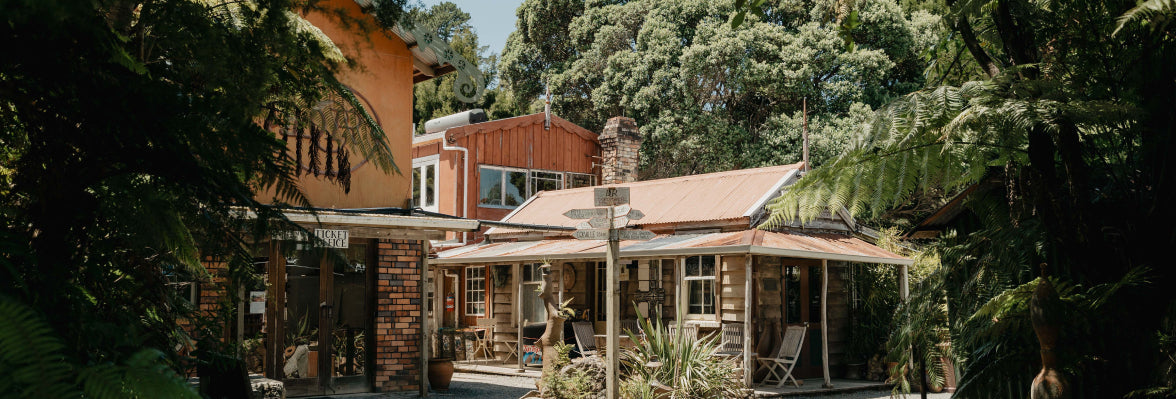
Safeguarding Giants: Protecting Kauri Trees While You Explore the Coromandel
The Coromandel Peninsula is a paradise for nature lovers, boasting stunning coastlines, verdant forests, and a unique collection of native flora and fauna. Amongst these treasures stand the majestic kauri trees, silent giants that have witnessed centuries unfold. We're fortunate to have some of these magnificent trees at Buffalo Lodge and some even older giants nearby.
We recently went to our neighbours who reminded us about some of the vulnerabilities of these precious trees and so we wanted to talk about these ancient giants who are facing a growing threat – kauri dieback disease. We want to share helpful information to support us all to be responsible Coromandel trampers (hikers) by taking steps to protect these taonga (treasures) for future generations.
The Enduring Majesty of Kauri Trees
Kauri (Agathis australis) are coniferous trees endemic to New Zealand, meaning they're found nowhere else on Earth. Their closest relatives reside in faraway lands like New Caledonia and Norfolk Island, hinting at an ancient Gondwanan origin dating back millions of years. Once towering over vast forests throughout New Zealand, kauri are now primarily found in the North Island, with the Coromandel being a crucial stronghold for these remarkable trees.
Kauri trees awe us with their sheer size. They can reach heights exceeding 50 metres, their ancient trunks stretching skyward for over 1,200 years, like the beloved giant at the Long Bay Kauri Walk. Their immensity yields high-quality timber, prized for its rich golden hues, tight grain, and exceptional durability. Unfortunately, this very quality led to a period of intense logging during New Zealand's colonial era, significantly reducing kauri populations. The significance of kauri extends far beyond lumber. Kauri gum, a resin produced by the trees, was a valuable resource, used for tools, weapons, and intricate carvings. The towering presence of the kauri also held spiritual significance, representing strength, wisdom, and longevity.
Thankfully, a growing awareness of the ecological and cultural importance of kauri trees led to stricter conservation measures in the early 20th century. Today, these giants are a protected species, and their remaining habitats are carefully managed for long-term survival.
The Threat of Kauri Dieback
Despite conservation efforts, a major threat looms over kauri trees – kauri dieback disease. This disease is caused by the microscopic pathogen Phytophthora agathidicida, which attacks the roots of kauri trees, ultimately leading to their demise. The pathogen spreads easily through the movement of contaminated soil on footwear and clothing. Tramping, or hiking, is a popular activity in the Coromandel and, unfortunately, unsuspecting trampers can unintentionally carry contaminated soil from infected areas to healthy kauri forests.
Protecting Kauri Trees: As a responsible tramper around the Coromandel, by following a few simple hygiene principles you can make a significant difference in protecting kauri trees:
- Clean Your Boots: Before and after exploring any kauri forests, including the beloved Long Bay Kauri Walk, thoroughly clean your footwear and any outdoor gear that may have come in contact with the soil. Here we provide everything you need to scrub your shoes thoroughly before and after your adventure. Many tramping tracks, including those in the Coromandel, have cleaning stations at the entry and exit points. It is important to do this once on the tramping track and once at cleaning station. Utilise these stations and follow the provided instructions for proper cleaning.
- Stay on Designated Tracks: Always adhere to designated tracks when exploring kauri forests. Staying on the track and not walking around in the bush amongst kauri trees minimises soil disturbance and reduces the risk of spreading the disease.
- Be Mindful of Signage: Pay close attention to informative signage placed along tramping tracks. These signs will often provide crucial information about kauri dieback and hygiene protocols.
- Spread Awareness: Educate yourself and others about kauri dieback. Sharing knowledge is an important tool in protecting these vulnerable trees.
Making a Difference
By adopting these simple practices you, as a responsible Coromandel tramper, play a vital role in safeguarding these ancient giants. Your commitment to hygiene and respecting designated tracks will ensure the Coromandel's kauri trees —including those at Buffalo Lodge — continue to grace our landscapes for generations to come.
Want to Learn More?
We encourage you to visit the Department of Conservation website for detailed information on kauri dieback disease and how you can help protect these taonga (treasures) of New Zealand.
A huge thank you to our lovely neighbours who provided us with pamphlets for our guests and the cleaning kit for all to use. And thank you in advance for your support in ensuring the Coromandel's kauri giants continue to stand tall for generations to come.










